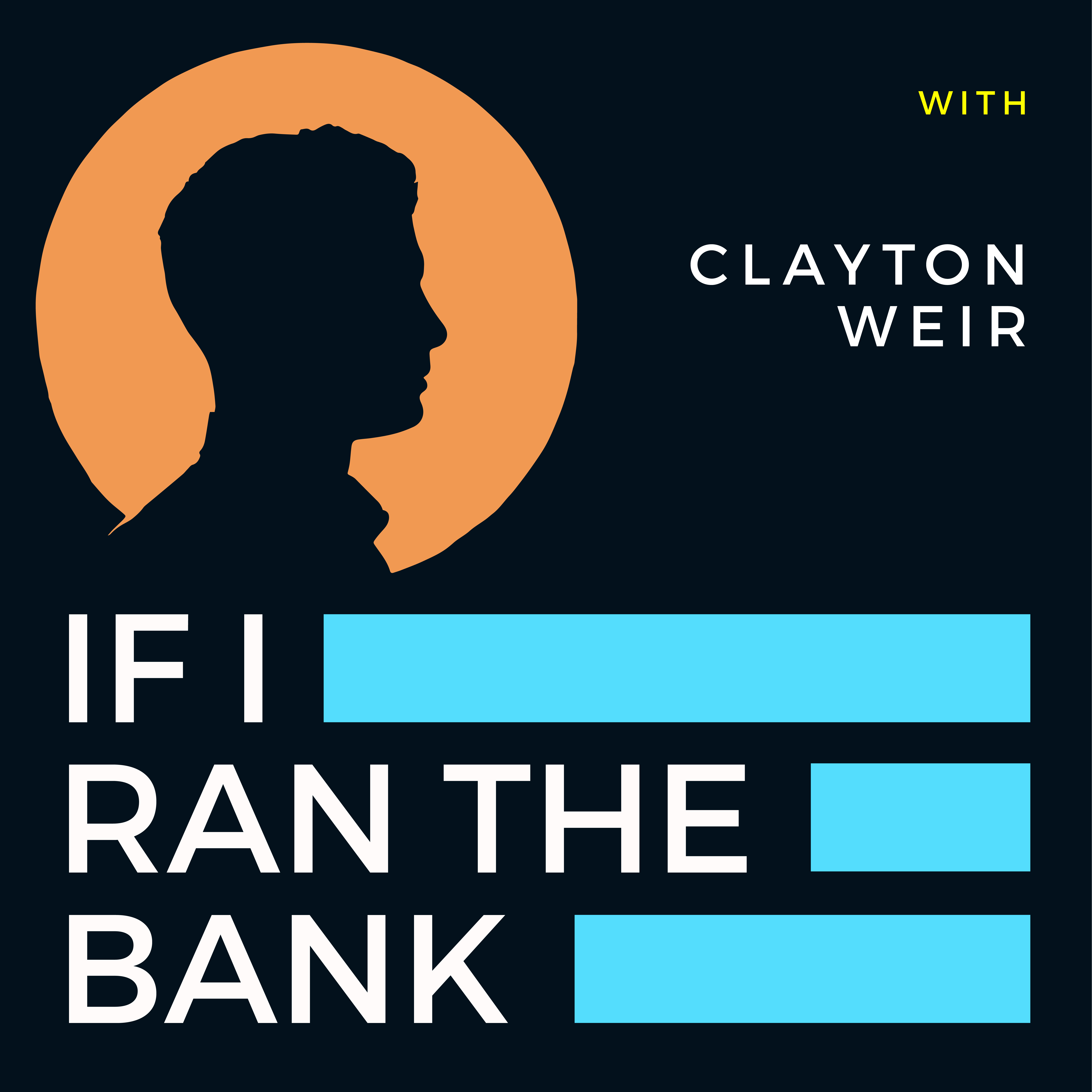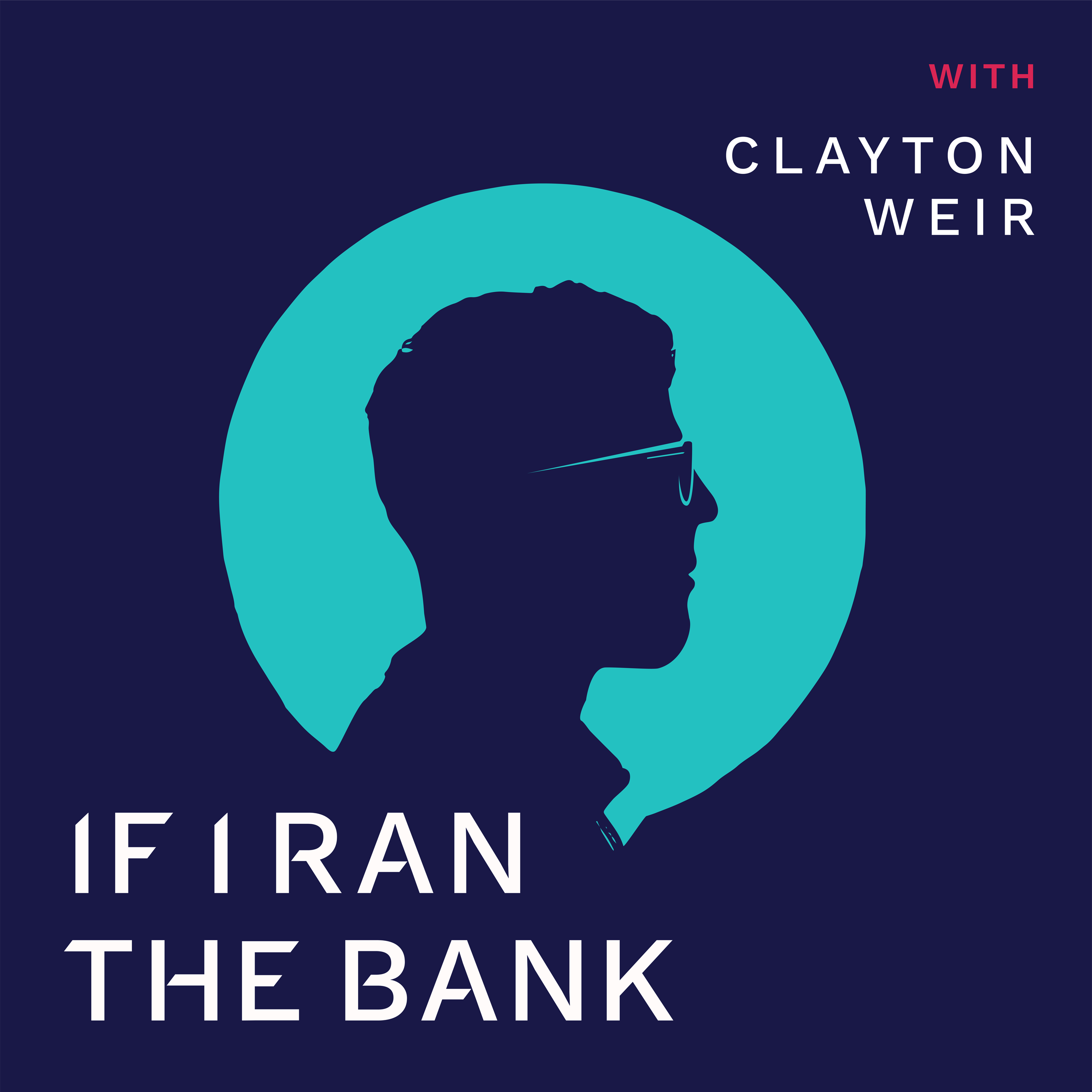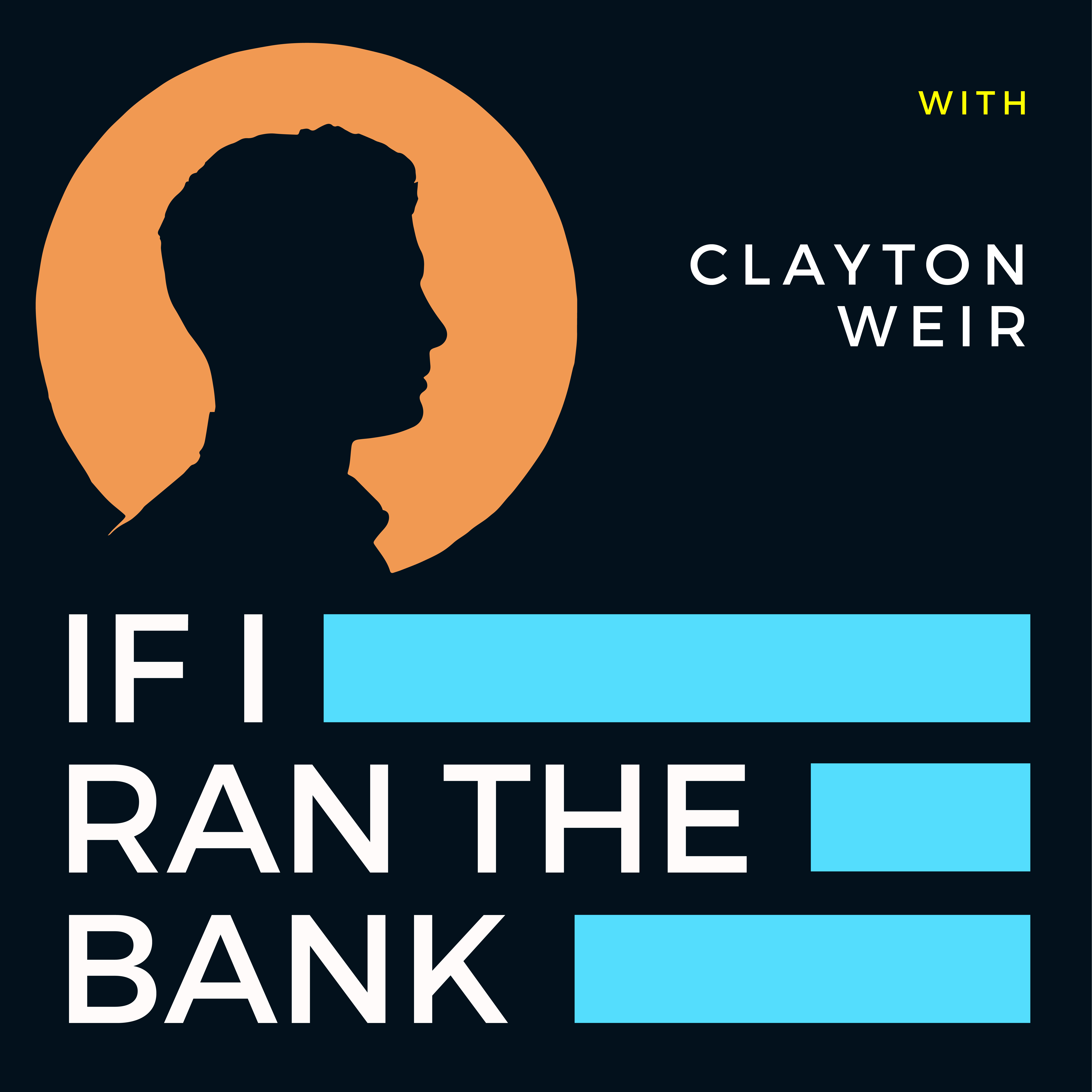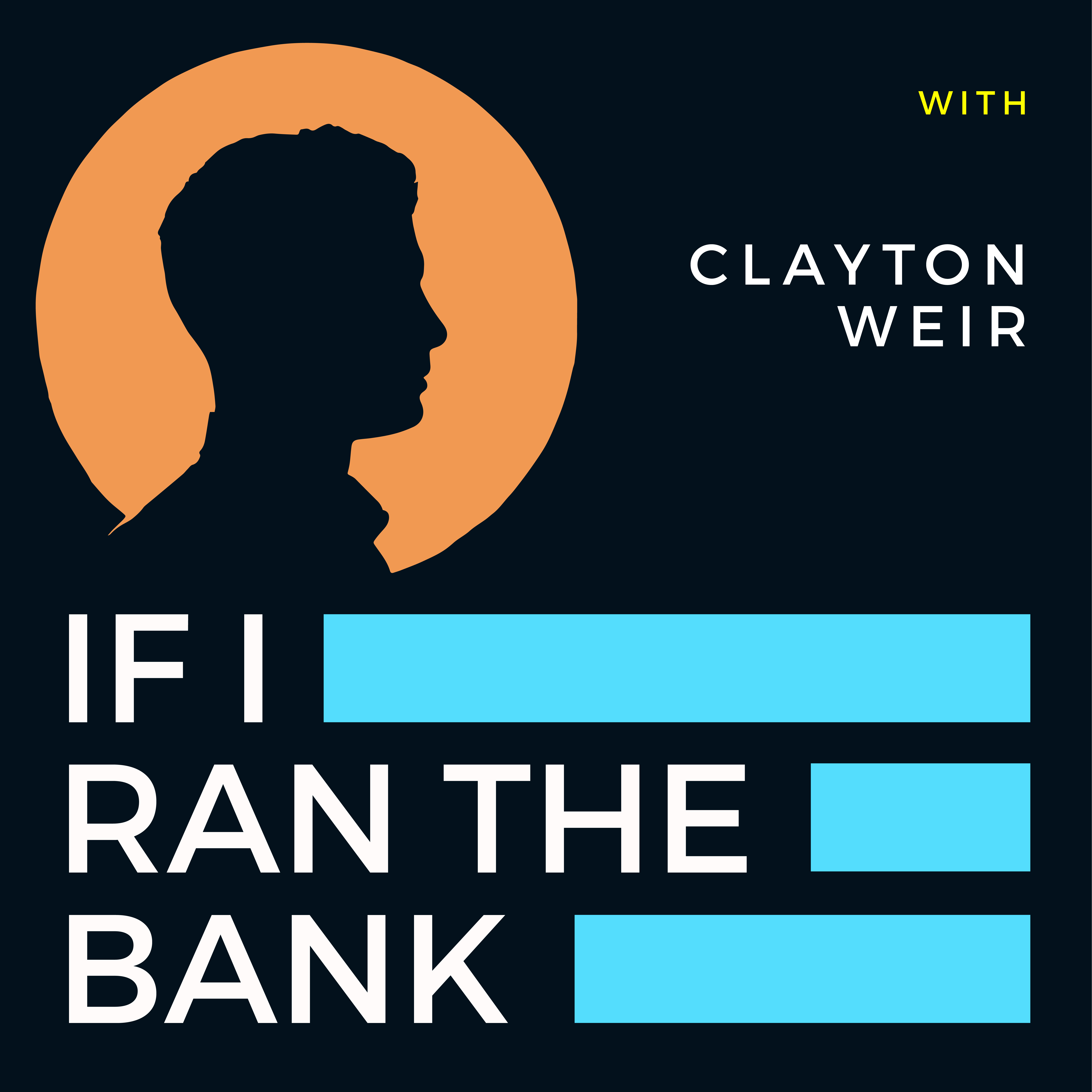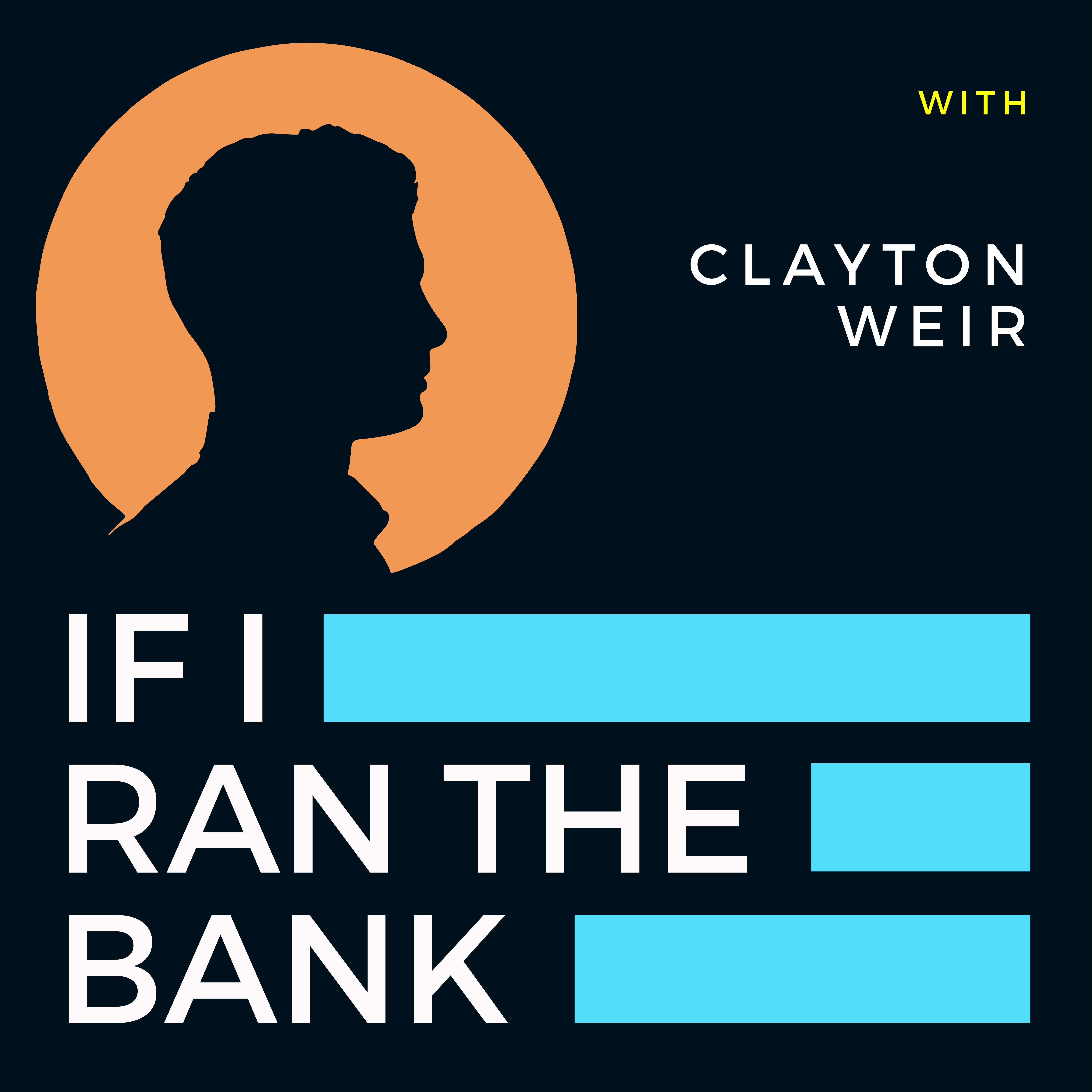The Road to a Better Payments Experience with Sandra Horvath
- 0.5
- 1
- 1.25
- 1.5
- 1.75
- 2
Voiceover: If I Ran the Bank is a podcast hosted by Clayton Weir, Co- Founder and Head of Product and Strategy at FISPAN. A FinTech that is enabling banks to provide contextualized consumer life experiences to their business clients. Clayton is a thought leader in financial innovation, and hits on the hottest topics in banking, and finance, and the future of payments, and he wants to know, if you ran the bank, what's the one thing you'd go all in on? Please tune into Spotify, Apple Podcasts, Google Play, or wherever you get your podcasts. And now, here's your host, Clayton Weir.
Clayton Weir: Hey, everyone. Welcome to another episode of If I Ran the Bank. My name's Clayton Weir. As always, I am your host. I'm super excited for today's guest. I have Sandra Horvath on. She is a very interesting person that that I've met and my partner, Lisa has met, in a different life as well, in a couple of different contexts. I would almost characterize Sandra as having had the unique chance to live through the whole value chain of financial services. A lot of time in the card network side, a lot of time importantly, in the Final Mile at Sage. Working in selling business applications, and embedded payments straight to small businesses, the tools they use to run their business. More recently working on, I guess some of the big challenges around payment modernization in Canada, as part of Payments Canada Stakeholder Advisory Council. More recently, I think working with Central One, who I guess is probably the best proxy for that would be something like the services that F. I. S and Fiserv do specific to the small regional banks in the U. S. where it's a blend of being a technology partner and an operational services' provider, something like that for the Canadian credit union and tier two financial services' ecosystem. Based on that, I think having had both existing on the First Mile, deep in the belly of the machine and the payment clearing schemes. I think why I actually have inaudible was more to talk about the Last Mile and how we distribute financial services to businesses and maybe how that could change and how banks to do a better job than that. Thanks for coming on the show. Sandra, did I capture, do you want to fill in the blanks on who we are?
Sandra Horvath: Thank you, Clayton. You did. I really appreciate that. So, yes, very true. I'm a payments' geek through and through, but from both sides of the coin, both working in the payments' industry and also working in the software industry where payments flow through, and primarily in the commercial side of things. So with that focus, most of my roles have been business development and market facing as well as strategy. I've touched on commercial card solutions at American Express, accounts payable systems with buyer initiated payments, to managing merchant acquiring efforts in the mid- market space Also strategic alliances for a large accounting software firm that included looking at payments integration. As you had mentioned, most recently supporting the expansion of modernized digital banking of the Credit Union system. Near and dear to my heart too over my career, is I've noticed there are not enough women in the space. Even when I was doing my tech MBA or in various meetings throughout my career, I was often the only one of few women in the room. I'm really an advocate for gender diversity in technology and payments as past president of a women in tech organization. I currently chair the Business Technology Management Industry Advisory Board for Simon Fraser University and I'm a member of the Dean's Forum. As you mentioned in the past, I've served on the Stakeholder Advisory for Payments Canada, representing the needs of small businesses, as it relates to payments modernization. I'm currently taking on projects and seeking my next big juicy business problem to sink my teeth into. With recovery of COVID around the corner, I really feel that it's timely for the industry to really, truly support small businesses in their ability to grow and flourish, so that's something I'm looking at.
Clayton Weir: So on that note, that's maybe a really good place to start. Do you want to maybe give us the Coles Notes of if you were setting in the Strategic Advisory Council of Payments Canada representing the voice of small businesses? What's your pitch? What do small businesses in need? Where in your mind does maybe the incumbent and financial technology players maybe let them down? Where are the opportunities in that?
Sandra Horvath: Well, definitely. Banks, they need to act more as technology companies, rather than just banks. I'll always speak in the business context of the commercial side of things, not the consumer, but the experience for a business, as I've seen it over the years throughout my career, has been really painful. There has been some progress, but the big one, I would say, is reconciliation. It is a huge pain point for businesses and there are reasons why we haven't been able to fix that over the years. One thing, one part of it, is that the Canadian banking infrastructure, the network, it has been legacy and not necessarily primed for innovation, but payments Canada is investing in modernizing. There's a couple initiatives happening today and that's the update of their large value transfer system to links, which will be better positioned for innovation. They're establishing real- time rail capabilities and they're aligning to global standards and passing enhanced data. With that, we now have the foundation to do these things and make lives better, the lives of business people better. The biggest piece to that around the reconciliation side is the development of ISO 20022 or the utilization of that standard, so that full remittance data will accompany the payment and with the ability to flow into the accounting software. With that, it's going to save a ton of time for businesses.
Clayton Weir: We mostly dove in on the show before and the ISO 20,022 stuff. I'm a deep proponent for the value of it, but it's interesting, right? Because obviously the payment clearing system needs to speak that language and have the ability to take all this rich contextual data, then the financial institutions need to get it from there. Then the portal needs to have it at the bank, further and further out. Ultimately it leads into, and I think this is what you think a lot about, but it leads into a massive either First Mile or Final Mile issue, where ultimately this needs to be something that corporates and small businesses need an on- ramp to take advantage of. Right?
Sandra Horvath: Right. That's very true. I recently read a report from Ernst& Young saying that poor payments processes for commercial organizations, costs them in Canada, over five- year period between 14 and$ 32 billion. It's a huge pain. It comes in a number of different forms. As we just talked about low auto match of payments to invoices, that's a big one. Limited visibility into what's happening in the supply chain, limited predictability of cash coming in, and also visibility in the cross border payments, and a lot of manual payment processing. That's where this figure of 14 to$ 32 billion comes in. With that, if we could utilize the new technologies that we'll have available to us and tackle these things, but to your point, we can't do that in a silo, and it can't just do that on its own, it has to share the data with all of the systems that a small business may choose to use. The opportunity for everybody in the supply chain is freeing up these dollars. You're making businesses more efficient when you're saving the money, and you've got products and services that will help them do that, that can also increase your own revenues. It'll increase the revenues of the business and everyone in the chain. This evolution, it's going to create new opportunities for everybody in the chain. I think what we don't see enough is collaboration across the chain. All of the focus right now is getting the work done, the technology in place, looking at that project. But what I would really advocate for, is the use cases. Working with other partner organizations, hone in on use cases that are just above and beyond, and give businesses a top- notch experience.
Clayton Weir: To dive in a little bit further on that, what are some of those, the use cases that you think should be top of the line or should have the most energy behind them?
Sandra Horvath: For sure. Well, the reconciliation one, so having the remittance data come into your financial management software. I think that we've seen incredible uptick of interact, for example, from a consumer to consumer perspective, it's such a great experience. I can just go into my phone, send money, see that immediately the recipient has access to those funds and away I go, I'm done. Well, that's not necessarily the norm for businesses. They don't have that kind of visibility. But having said that, it's something that we can do in a business context. Interact, for example, is enhanced their systems to have a higher threshold. I think it's around$25, 000, as well as the enhanced data. One use case I could see is your accounting software and you initiate and interact E- transfer to a business that you're paying, or that you easily accept that transfer from a business that is paying you. You're saving money doing that because when businesses use a credit card, there's the interchange fees and it's a lot less expensive. There's a lot of consumer technologies that are not fully utilized in a business context yet, so that's another example. Another one, when you combine the power of your accounting software and the data that a financial institution holds, is lending. That's a major pain point for businesses, as well as the lending relationship. It still can be very manual, where you're applying for a loan, you're not quite sure when you might need it, how much you might need, what the rate is, sending them the information, whereas all of that exists. If we could look at a cross organization process where you've got better visibility into the payments chain and a business, we'll see," Oh three months from now, it looks like I might need a loan. My system flags me and says, okay, it looks like you might need that loan. We predict based on your receivables and the timing, it's going to be about$ 5, 000. Based on the health of the organization, you should get a rate of approximately X. Did you want to trigger the request to such and such a financial institution because based on their parameters, you are pre- approved." Can you imagine? Right? But today that experience is very different.
Clayton Weir: All the points you raised are great and merit a deeper dive. The lending one is probably one of the things that I've thought about the most as I've gone through the podcast. It's simple, but it's profound in the sense that the way that banks have lent to small businesses is historically, almost always been on an asset basis. The whole system was set up that you have a factory and you have a building and machines. They're very good at that historically. Generally, for smaller businesses, it hasn't really been, it's either owner personal revolving credit, or later cashflow tied. But for most businesses, they're not really good at cashflow type lending. As businesses have become less asset intensive, it's created this deeper and deeper financing and gap that way. It's harder to match, but realistically data, Throughput data is the asset you're lending against now. We've seen that at the merchant terminal. We've seen it on the revenue side with the... I can't think of what's Michelle Romanow's business. I'm not thinking at all. Anyways, but the lending against SaaS subscriptions, all those kinds of things like that. That is how businesses are going to lend, just with using real- time data access to operational data to underwrite. I don't think a lot of F. I.'s are good at that today.
Sandra Horvath: Yeah. I think we need to make borrowing a lot easier for businesses. Many of them rely on their own personal credit cards, business cards, because it's easy, but that's not to say that... Banks are wondering, well, how do we increase our own revenues? They can do that through more lending, just by making the process frictionless and easier to access. Absolutely, you have to mitigate risk, but the more pervasive data is through the payments networks and through the software that we use, as everything is moving to SaaS based, it's a matter of sharing that data to mitigate risks, provide the information that's needed and access to the lending that's needed, when it's needed. I totally agree with you.
Clayton Weir: ClearBank was the brand that I couldn't think of earlier. On that note, the other thing that I think is interesting about some of these big points you've raised, is to some extent, these are all things that I think the card networks themselves have figured out early. I'm just even thinking on the lending side, like your former employer, they just bought, I think the largest non- bank FinTech lender to businesses in the last year in Kabbage. It's very interesting how they always have their nose into these things early.
Sandra Horvath: Yeah, it's very true. That was my first foray into the payment space, was working for American Express. I really loved it. It was really about looking at a situation and saying, hey, it's costly to issue a purchase order and time consuming and arduous. Is there an easier way to do this? Well, this commercial card product exists and it is, it's an easier way to spend and receive payments, but there needed to be some controls in place. A commercial card will allow you to limit how much the dollars, which employees, what suppliers, so it can completely eliminate purchase orders, but of course the data is a critical piece to it. There was under utilization of commercial cards in the market at the time and that's what I was tasked with looking at. It was a really fun problem to look at because utilizing the system would save companies money, but there was an acceptance issue in some cases. We overcame that by really honing in on who were the most important suppliers, getting them onboard, getting their customers to advocate for the processes that they needed and just connecting the dots. What I find is that, often what needs to happen is the technologies are there, the value prop is there, we just need to connect the dots and make it possible for businesses to utilize some of these solutions and services.
Clayton Weir: I totally agree. Even business to business, card purchasing, in some ways it is a decent prototype for what you might expect in the ISO network because to trigger the business class interchange, you had to pass off a bunch of structured, contextual data about invoices through the network. It's realistically in every way, a prototype for the kinds of buyer, supplier interactions you might expect in an ISO payment network.
Sandra Horvath: Yeah. That's very true. There was at L3 pricing. The more data that a supplier would send, the better the rate that they would pay. Today, where there's so much focus is the development of APIs. Well, this is just going to open up Pandora's gate of data. I think that's the other challenge that we have to look at. We will have access to so much data now, but how can we best utilize it, for the customer and giving them the insights that they need real time, at the time that they need to make their decisions. It's becoming easier, much, much easier, for organizations to pass the data. Of course, it always has to be done in a secure fashion, so there is the need to ensure security and data integrity. I think that also becoming easier. What's particularly interesting to me too, with what's happening globally, is open banking. More data is being passed in other regions. It's also very interesting to see what they're doing with it. One example I see is, there's a company in Australia and they're partnered with a bank, and you initiate bank transactions from within your accounting software. There's far more blurring of the lines between the banking portal and other places where you interact with your own money and the data flow between organizations as that happens. It's exciting times. Like I said, I just happen to be particularly interested in it.
Clayton Weir: Yeah. It's exciting times as long as you don't have any other interests in life, don't have other hobbies.
Sandra Horvath: That's right.
Clayton Weir: For people like us. I think you hinted on something good there with the example from Australia. Obviously, I have a deep bias towards believing that business applications are an important point of consumption, but this is an interesting point, right? You talked about this just before we hit record, about the Final Mile experience. None of this infrastructure, none of these APIs, none of this stuff is useful to you as a small business, until it is something you can use. I think obviously for financial institutions, I think in lots of cases, there're certain institutions where the culture is like," We are the Final Mile. Our products and our channels are the Final Mile." My opinion is that isn't true for most cases. It's actually where the client lives, which in oftentimes are these accounting systems or other operational finance tools. Do you want to maybe share your thinking around that and having lived obviously deeply in that world with those small businesses? Do you want to maybe surface how those things do or don't come together?
Sandra Horvath: Yeah, absolutely. I think the missing piece to it too, is that you have product teams, product development management teams, that are just looking at their portion of the experience. If you had ideation sessions or a combined roadmap, between a financial institution and a software company to say," This is the experience, this is the ideal experience that we're after. What do we need in our combined roadmap to achieve that?" It's interesting. I worked with Apple actually on an ecosystem that they're developing, as they want to get more into the business side of things. I find that really interesting, this development with this idea of ecosystems. In their case, they're looking at a set of business related apps and they're promoting the value proposition behind having a combination of these apps." Here's an app that's related to POS, and here's a cloud accounting app, and here's a payroll piece, or here's time management," or whatever, and serving up these combined solutions. That's one way. It'll provide a certain level of congruent experience going to market in that way. I think to become best in class at one specific use case, that you need to get to that next level and have products, the technical teams and planning teams sit together and then just make sure there's absolutely no gaps in the experience and that it's frictionless and seamless to that business.
Clayton Weir: The world you've just described in some ways almost sounds a bit like a high school dance. Business applications are the wallflowers on one side and the financial incumbents may be on the other side and everybody wants somebody else to ask them to dance. How do you see that playing out? Who do you think has more work to do here? How could you see that rolling out, changing over time?
Sandra Horvath: Right. The Canadian market is a little bit different in that we're an oligopoly, to a certain degree. There's probably been less motivation than in other markets to move forward with much of this innovation that's required. Let me think about that. How do we get together? How do we come to the depths of, as you sort of described it? Well, one thing that I am seeing, and kudos to the F.I.'s (financial institutions) is you can tell they're sensing the disruption. As I was mentioning before, there's blurred lines between the banking experience and other business related processes and experiences. I'm seeing them create these innovation hubs, most of them have this, where they are looking at Fintech's and Paytech's and saying," Okay, where might we partner, or we might want to acquire, or we might want to look at this idea, this innovation, and see how it might work for our customer base and within our organizations." Some work is happening there which I think is fantastic. There's phenomenal Fintech's both in Canada and the U. S. to work with. That's how innovation is going to happen. It's going to be the F. I.'s being open to it. Then also down the road, greater access to our to payments networks, directly for the FinTech community. That's not quite there yet, but we'll see greater openness in future. But for now, just having that prioritization around innovation and working with Fintech's and Paytech's as a community, is what's going to bring some of this stuff to market. The F. I.'s really need to, because the pressures on the competitive. Competitiveness is not between financial institutions anymore. It's any provider out there that provides us a superb digital experience. You have to... The bar is high now.
Clayton Weir: I agree with that point completely. I think that's the point you can never lose, is that the expectations are higher than they ever were and are probably increasing at a rate that they never can. It just doesn't, I've said this before, probably on this podcast, but the oldest millennials are quite old now. They're in their forties. The world is just different. Those are the CFOs of the companies that you want to bank. They are digitally native. That's all changed, swept up on us. They aren't really snot nosed kids anymore.
Sandra Horvath: That's a driver for the Credit Union space as well, because much of their business has been community- based and going into your local branch. As that happens less and less, they're really having to reinvent themselves and providing that superior digital experience. But they're also pretty nimble. They can leap frog in a lot of ways, versus a really large F. I., that's going to take a while to move the machine. They do have some flexibility to do some unique things for their clients too. But definitely it's, especially in the Credit Union space, there has to be a focus on a much younger demographic. It's critical. I would say, look at the data that's coming. Look at what's available traveling with a payment today. What will be available in future? Both the data and the aspect of payment speed as well. With that, with better information or greater information passing through faster, what current experiences that are clunky or could be improved, do we want to solve for? The biggest point that I wanted to make, is don't do it in a silo. Look at your target organization, profile them and say," Okay, I'm looking at a business of 100 employee size. What are the most common solutions that they use? This is the accounting software that they use. This is the processor that they use in their region. These are the apps that they use. This is a payroll system that they use. This data,, that will now be flowing through the system, how can we look at it and go above and beyond and get rid of some of the stickiness, or get rid of some of the friction, I should say, and the cumbersome processes? Look at what we were talking about earlier, really cheques exist? Well, they exist for a reason. Let's get rid of all of those obstacles and just get rid of them. That would be my recommendation. Look from the standpoint, the empathetic, the standpoint of the business, look at the systems that they use and look at the power of the data that's going to be coming.
Clayton Weir: I agree on all those fronts. I'm also, going to plug, I think it's episode two, or if maybe it's episode three of this, three or four of this podcast, which is Three Steps to Kill the Small Business Cheque. Certainly something to think of. It is bizarre that they still exist in this day and age, but they have a profound beauty in their persistence. We shouldn't hate them. We shouldn't hate them because crosstalk. I agree that they'll be from the future. In general, I appreciate you taking the time to come on the show today. This has been great. If I just want to do a quick around the horn, I think you're inviting banks to think about the Final Mile experiences that they can build for their constituent business customers on top of all of this wave of payment modernization. Things that make it easier to reconcile their books, make the state of payments more visible, more faster, more easy, have new and smart ways to provide access to credit for those same users. I just want to thank you for the thoughts. I think it's a really important a way to frame the conversation.
Sandra Horvath: I really appreciate it. Thanks for having me. This was a lot of fun.
Clayton Weir: Awesome. Well, thanks everyone for listening. As always, would absolutely love for you to subscribe on Spotify or Apple podcasts or wherever you get your podcasts if you haven't. If you think somebody would be interested then it's always great to forward this to a friend. If you have any questions, comments, or concerns, never hesitate to email info @ fivespan. com. That's F. I. S. PA. N. com and look forward to seeing you all next time.
DESCRIPTION
Sandra Horvath is a technology industry business development leader and consultant with a background in business software and payment systems. Sandra joins Clayton on this week’s episode to discuss how banks can provide a better payments experience to their small business clients.
Today's Host

Clayton Weir
Today's Guests


